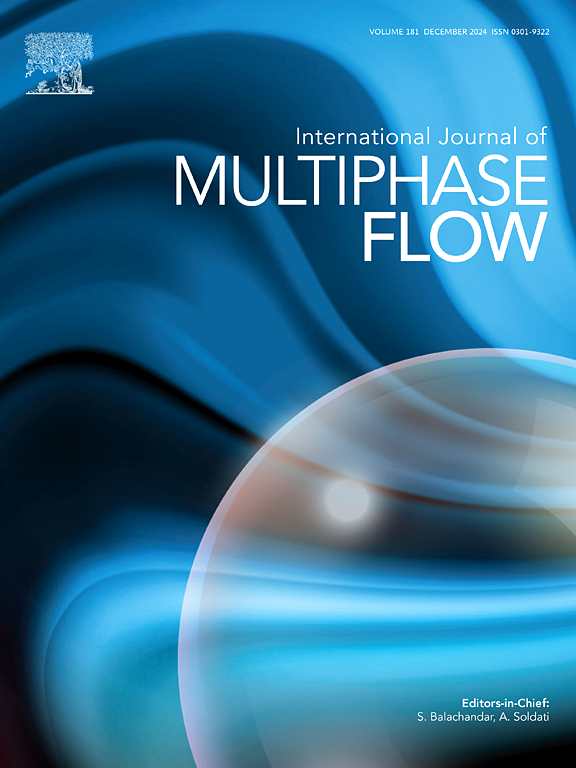On the unsteady behavior of a freely closed ventilated supercavity at low Froude numbers
IF 3.8
2区 工程技术
Q1 MECHANICS
International Journal of Multiphase Flow
Pub Date : 2025-09-24
DOI:10.1016/j.ijmultiphaseflow.2025.105464
引用次数: 0
Abstract
An experimental study was conducted to examine the unsteady flow characteristics of a freely closed ventilated supercavity induced by a disk-shaped cavitator. Within the explored parameter range, four distinct cavity closure modes were identified: Foam Cavity (FC), Twin Vortex (TV), hybrid Foam Cavity and Re-entrant Jet (FCRJ), and hybrid Twin Vortex and Re-entrant Jet (TVRJ). Among these, the Twin Vortex mode was most commonly observed at low Froude numbers, characterized by periodic shedding of small bubbles and the presence of a pair of vortex tubes connected to the cavity tail, exhibiting regular breakup events and fluctuations in both diameter and axial position. High-precision dynamic pressure sensors was employed to investigate spectral features of internal cavity pressure and surrounding ambient pressure across various closure modes and flow conditions. Results revealed that, in the low-frequency range 0∼50Hz, incoming flow disturbances predominantly influenced cavity pulsations, whereas cavity oscillations themselves also significantly affected pressure fluctuations in the external flow field. In the intermediate-frequency range 50∼300Hz, distinct energy peaks emerged, attributable to intrinsic unsteady flow structures within the supercavity. Moreover, at high-frequency range 300∼3000Hz, evenly spaced spectral peaks were observed, corresponding to the excitation of standing wave modes within the slender supercavity body.

低弗劳德数下自由封闭通风超腔的非定常行为
通过实验研究了由圆盘形空化器诱导的自由封闭通风超空腔的非定常流动特性。在所探索的参数范围内,确定了四种不同的空腔闭合模式:泡沫空腔(FC)、双涡(TV)、泡沫空腔与再入射流混合(FCRJ)和双涡与再入射流混合(TVRJ)。其中,双涡模式在低弗劳德数时最常见,其特征是小气泡周期性脱落,并且存在一对连接到腔尾的涡管,表现出规律的破裂事件以及直径和轴向位置的波动。采用高精度动态压力传感器研究了不同封闭方式和流动条件下腔内压力和周围环境压力的频谱特征。结果表明,在0 ~ 50Hz的低频范围内,来流扰动主要影响空腔脉动,而空腔振荡本身也显著影响外部流场的压力波动。在50 ~ 300Hz的中频范围内,由于超腔内固有的非定常流结构,出现了明显的能量峰。此外,在300 ~ 3000Hz的高频范围内,观察到均匀间隔的光谱峰,对应于细长超腔体内驻波模式的激发。
本文章由计算机程序翻译,如有差异,请以英文原文为准。
求助全文
约1分钟内获得全文
求助全文
来源期刊
CiteScore
7.30
自引率
10.50%
发文量
244
审稿时长
4 months
期刊介绍:
The International Journal of Multiphase Flow publishes analytical, numerical and experimental articles of lasting interest. The scope of the journal includes all aspects of mass, momentum and energy exchange phenomena among different phases such as occur in disperse flows, gas–liquid and liquid–liquid flows, flows in porous media, boiling, granular flows and others.
The journal publishes full papers, brief communications and conference announcements.

 求助内容:
求助内容: 应助结果提醒方式:
应助结果提醒方式:


